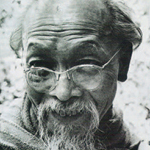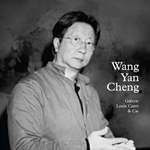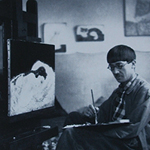Foujita
“Foujita’s destiny was to be born Japanese and die French. His art was fated, for posterity’s sake, to become the perfect link between Eastern and Western art.” Sylvie Buisson
Like Leonardo da Vinci, whose first name he adopted, Foujita successfully experimented in many artistic fields – painting, drawing, engraving, ceramics, photography, cinema and even fashion.
Tsuguharu was born in Japan in 1886 into an educated family who were open to Western culture. He learned French and studied at the Tokyo College of Fine Arts. From then on, he dreamt of moving to Paris. His wish was granted in 1913, when he arrived in Montparnasse. The day after his arrival, by sheer good luck, he visited Pablo Picasso’s studio, where he discovered the works of the master as well as those of Douanier Rousseau. It was a revelation. Liberated from his academic studies, the young artist gave himself over body and soul to modern art. He became one of the leading figures of the Paris School, and Kiki de Montparnasse was his favourite model at the time. In 1917, Georges Chéron organised his first solo exhibition. Foujita’s sucess was phenomenal, and his work soon appeared in all the painting salons in Paris, as well as throughout Europe, the US and Japan. The artist’s singular style, a link between East and West, was at the root of his success, so much so that he became a Chevalier of the Légion d’Honneur in 1925.
Foujita was soon to meet Madeleine Lequeux. Lequeux, nicknamed “the panther”, was a dancer at the Casino de Paris, and soon became the partner of the most Parisian of Japanese painters. The two lovers went on a world tour in 1930, which took them to Latin America, then to China, and finally to Japan, where they received a warm welcome. Unfortunately, Madeleine died of an overdose in 1936. After many wanderings, Foujita returned to Paris in 1950 and became a French citizen five years later. During a visit to the basilica of Saint-Remi in Reims, he was called to Christianity, converted to Catholicism and asked to be baptised. He devoted the last years of his life to the frescoes in the chapel of Notre-Dame-de-la-Paix in Reims, known as Foujita’s chapel, where he now rests.
Our evaluation enables us to assert the pictorial and technical quality as well as the condition of a work before giving an evaluation of its historical and cultural interest. Advice may be given in terms of additional research to be conducted and also an estimate, whether the work is intended for auction or to be sold through another means.
Are you the owner of archive material or additional material about Asian painters, or would you like one of your works assessed? Contact us
More information by clicking on the photos
Are you the owner of archive material or additional material about Asian painters, or would you like one of your works assessed ? Contact us






















